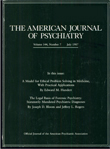Religion, psychopathology, and substance use and abuse; a multimeasure, genetic-epidemiologic study
Abstract
OBJECTIVE: The authors sought to 1) understand the sources of familial resemblance for religiosity, 2) clarify the relationship between religiosity and current psychiatric symptoms, current substance use, lifetime psychiatric disorders, and lifetime substance dependence, and 3) explore the stress-buffering properties of religiosity. METHOD: Data were obtained by personal interview of 1,902 twins from female-female pairs in the population-based Virginia Twin Registry. Measures included 1) 10 items reflecting a range of religious behavior and beliefs, 2) a scale of institutional conservatism of current religious affiliation, 3) previous history of stressful life events, 4) current psychiatric symptoms and substance use, and 5) lifetime psychiatric disorders and substance dependence. Statistical methods used included factor analyses, Cox and linear regression, and twin modeling. RESULTS: Personal devotion and personal and institutional conservatism were all strongly familial, and model fitting suggested that this familial resemblance was due largely to the effect of environmental factors. None of the dimensions of religiosity was strongly associated with lifetime psychopathology or current symptoms, but low levels of depressive symptoms were related to high levels of personal devotion. By contrast, personal devotion and personal and institutional conservatism were significantly and inversely associated with current levels of drinking and smoking as well as lifetime risk for alcoholism and nicotine dependence. Personal devotion, but not personal or institutional conservatism, buffered the depressogenic effects of stressful life events. CONCLUSIONS: The dimensions of religiosity are not strongly related to risk for psychiatric symptoms and disorders. However, religiosity may be one of the more important familial- environmental factors that affect the risk for substance use and dependence. Religious devotion but not conservatism assists in coping with stress.



